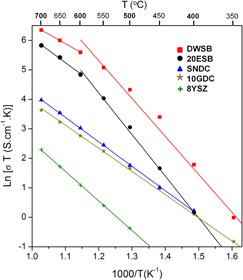Crossref Citations
This article has been cited by the following publications. This list is generated based on data provided by
Crossref.
Sadykov, V.
Usoltsev, V.
Yeremeev, N.
Mezentseva, N.
Pelipenko, V.
Krieger, T.
Belyaev, V.
Sadovskaya, E.
Muzykantov, V.
Fedorova, Yu.
Lukashevich, A.
Ishchenko, A.
Salanov, A.
Okhlupin, Yu.
Uvarov, N.
Smorygo, O.
Arzhannikov, A.
Korobeynikov, M.
and
Thumm, Ma.K.A.
2013.
Functional nanoceramics for intermediate temperature solid oxide fuel cells and oxygen separation membranes.
Journal of the European Ceramic Society,
Vol. 33,
Issue. 12,
p.
2241.
Lee, Kang Taek
Lidie, Ashley A.
Jeon, Sang Yun
Hitz, Gregory T.
Song, Sun Ju
and
Wachsman, Eric D.
2013.
Highly functional nano-scale stabilized bismuth oxides via reverse strike co-precipitation for solid oxide fuel cells.
Journal of Materials Chemistry A,
Vol. 1,
Issue. 20,
p.
6199.
Kendrick, Emma
and
Slater, Peter R.
2013.
Battery and solid oxide fuel cell materials.
Annual Reports Section "A" (Inorganic Chemistry),
Vol. 109,
Issue. ,
p.
396.
Ling, Chris D.
Schmid, Siegbert
Blanchard, Peter E. R.
Petříček, Vaclav
McIntyre, Garry J.
Sharma, Neeraj
Maljuk, Andrey
Yaremchenko, Aleksey A.
Kharton, Vladislav V.
Gutmann, Matthias
and
Withers, Ray L.
2013.
A (3 + 3)-Dimensional “Hypercubic” Oxide-Ionic Conductor: Type II Bi2O3–Nb2O5.
Journal of the American Chemical Society,
Vol. 135,
Issue. 17,
p.
6477.
Lunca Popa, P.
Sønderby, S.
Kerdsongpanya, S.
Lu, J.
Bonanos, N.
and
Eklund, P.
2013.
Highly oriented δ-Bi2O3 thin films stable at room temperature synthesized by reactive magnetron sputtering.
Journal of Applied Physics,
Vol. 113,
Issue. 4,
Geffroy, P.-M.
Fouletier, J.
Richet, N.
and
Chartier, T.
2013.
Rational selection of MIEC materials in energy production processes.
Chemical Engineering Science,
Vol. 87,
Issue. ,
p.
408.
Ni, Meng
Shao, Zongping
and
Chan, Kwong
2014.
Modeling of Proton-Conducting Solid Oxide Fuel Cells Fueled with Syngas.
Energies,
Vol. 7,
Issue. 7,
p.
4381.
Lee, Kang Taek
Lidie, Ashley A.
Yoon, Hee Sung
and
Wachsman, Eric D.
2014.
Rational Design of Lower‐Temperature Solid Oxide Fuel Cell Cathodes via Nanotailoring of Co‐Assembled Composite Structures.
Angewandte Chemie International Edition,
Vol. 53,
Issue. 49,
p.
13463.
Lee, Kang Taek
and
Wachsman, Eric D.
2014.
Role of nanostructures on SOFC performance at reduced temperatures.
MRS Bulletin,
Vol. 39,
Issue. 9,
p.
783.
Wachsman, Eric
Ishihara, Tatsumi
and
Kilner, John
2014.
Low-temperature solid-oxide fuel cells.
MRS Bulletin,
Vol. 39,
Issue. 9,
p.
773.
Lee, Kang Taek
Lidie, Ashley A.
Yoon, Hee Sung
and
Wachsman, Eric D.
2014.
Rational Design of Lower‐Temperature Solid Oxide Fuel Cell Cathodes via Nanotailoring of Co‐Assembled Composite Structures.
Angewandte Chemie,
Vol. 126,
Issue. 49,
p.
13681.
Gomez, Celia L.
Depablos-Rivera, Osmary
Medina, Juan C.
Silva-Bermudez, Phaedra
Muhl, Stephen
Zeinert, Andreas
and
Rodil, Sandra E.
2014.
Stabilization of the delta-phase in Bi 2 O 3 thin films.
Solid State Ionics,
Vol. 255,
Issue. ,
p.
147.
Enrico, Anna
and
Costamagna, Paola
2014.
Model of infiltrated La1−Sr Co1−Fe O3− cathodes for intermediate temperature solid oxide fuel cells.
Journal of Power Sources,
Vol. 272,
Issue. ,
p.
1106.
Enrico, Anna
Cannarozzo, Marco
and
Costamagna, Paola
2014.
Modeling Analysis of Bi-Layer Ni-(ZrO2)x(Y2O3)1−x Anodes for Anode-Supported Intermediate Temperature-Solid Oxide Fuel Cells.
Energies,
Vol. 7,
Issue. 9,
p.
5647.
Jung, Doh Won
Lee, Kang Taek
and
Wachsman, Eric D.
2014.
Terbium and Tungsten Co-doped Bismuth Oxide Electrolytes for Low Temperature Solid Oxide Fuel Cells.
Journal of the Korean Ceramic Society,
Vol. 51,
Issue. 4,
p.
260.
Bandyopadhyay, Swagata
and
Dutta, Abhigyan
2015.
Microstructure and charge carrier dynamics in Dy substituted phase stabilized cubic Bi2O3.
RSC Advances,
Vol. 5,
Issue. 80,
p.
65123.
Hou, Jie
Liu, Fengguang
Gong, Zheng
Wu, Yusen
and
Liu, Wei
2015.
Different ceria-based materials Gd0.1Ce0.9O2−δ and Sm0.075Nd0.075Ce0.85O2−δ for ceria–bismuth bilayer electrolyte high performance low temperature solid oxide fuel cells.
Journal of Power Sources,
Vol. 299,
Issue. ,
p.
32.
Hou, Jie
Bi, Lei
Qian, Jing
Zhu, Zhiwen
Zhang, Junyu
and
Liu, Wei
2015.
High performance ceria–bismuth bilayer electrolyte low temperature solid oxide fuel cells (LT-SOFCs) fabricated by combining co-pressing with drop-coating.
Journal of Materials Chemistry A,
Vol. 3,
Issue. 19,
p.
10219.
Lagaeva, J.
Medvedev, D.
Demin, A.
and
Tsiakaras, P.
2015.
Insights on thermal and transport features of BaCe0.8−Zr Y0.2O3−δ proton-conducting materials.
Journal of Power Sources,
Vol. 278,
Issue. ,
p.
436.
Evans, Anna
Martynczuk, Julia
Stender, Dieter
Schneider, Christof W.
Lippert, Thomas
and
Prestat, Michel
2015.
Low‐Temperature Micro‐Solid Oxide Fuel Cells with Partially Amorphous La0.6Sr0.4CoO3‐δ Cathodes.
Advanced Energy Materials,
Vol. 5,
Issue. 1,



